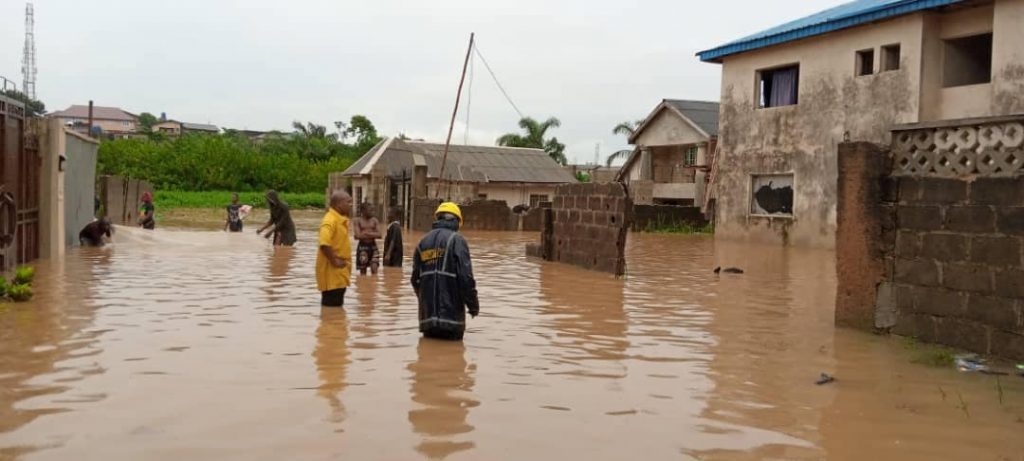Ayodele Olalere
In late September this year, Kogi State began to experience one of the flood disasters in Nigeria. The Niger and Benue rivers broke their banks and overran the state.
Hundreds of homes were submerged, in the state capital, Lokoja and some local government areas along the Niger and Benue rivers. As of now, nine local governments; Lokoja, Kogi-Koto, Ajaokuta, Ofu, Igalamela-Odolu, Bassa, Idah, Ibaji and Omala have been affected with thousands displaced and now housed in schools and other camps, while several lives have been lost.
The Kogi flood had been described as ‘a serious humanitarian tragedy’ by the state Governor, Yahaya Bello, as the state is now in dire need of food, shelter, and medical assistance to cater for thousands of victims of the flood.
READ ALSO: http://2023: Sanwo-Olu begins campaign at Ehingbeti Summit, calls Jandor, others ‘noisemakers’
It’s not an overstatement that 2022 has witnessed constant and more rainfalls in every part of Nigeria, resulting in many rivers and dams across the country overflowing their banks and causing flooding more than in recent years.
A report by the Federal Government indicated that in September alone, over 300 people died and 100,000 were displaced by floods across Nigeria.
Kogi is not the only state that has been affected by the flood. A report that the National Emergency Management Agency (NEMA) published on October 4, 2022, stated that Enugu State was also hit. In the Uzo-Umani local government of Enugu, about 35,200 people were reportedly affected by flood while 53,800 hectares of farmland were submerged, and houses, schools, worship centres and other public facilities were destroyed in the state.
The incidents have made flooding a national issue and concern which needed urgent attention.
In Bayelsa State, the Task Force on Flood Mitigation and Management visited some affected communities for an on-the-spot assessment of the impact at the weekend.
The task force visited communities in Yenagoa and Kolokuma/Opokuma Local Government Areas including Tombia-Ekpetiama, Odi, Sampou, Kaiama, Gbaranma, Sabagreia, Okoloba, Biseni and neighbouring communities as well as some areas within the Yenagoa metropolis.
Commissioner for Environment and chairman of the task force, Iselema Gbaranbiri, lamented the impact of the flooding in Biseni community, which, he said, was almost totally submerged.
Gbaranbiri sympathised with the people of the area on behalf of Governor Duoye Diri whom, he said, was passionate about their well-being hence the setting up of the task force on flood mitigation last Wednesday during the state executive council meeting.
On the situation in parts of Kolokuma/Opokuma LGA such as Odi and Sampou, Gbaranbiri said both communities were relatively safe at the moment due to the water barrier built by the government while areas like Gbarama, Sabagreia, Okoloba and Kaiama were heavily impacted with institutions such as the Ijaw National Academy, the Girls Secondary School in Kaiama and the Bayelsa State Sports Institute at Asoama flooded.
The commissioner explained that the essence of the on-the-spot assessment was to get first-hand information about the situation and identify areas of need for government to provide succour to the people.
Also, the Director of Operations, Bayelsa State Emergency Management Agency (BYSEMA), Mr Ayii Aziowei, sympathised with those affected, assuring that the government would do its best to provide relief to victims.
Lagos, Nigeria’s centre of commerce is also impacted by the flooding it sits on the water with a densely populated small land space.
It’s estimated that about 6,000 people move into Lagos from other states daily.
READ ALSO: http://Sanwo-Olu opens Peace Park in Ketu, commits youths to progress
Many of the communities in Lagos are situated close to the ocean while many residents reside on the banks of the Ogun river.
Therefore, every year, Lagosians suffer the destructive effects of flooding aggravated by climate change.
With this year’s torrential rainfall, communities in flood-prone areas, especially those residing on the banks of the Ogun river have been warned by the Lagos State Government to vacate their homes and relocate to safer territories.
In July alone, seven people reportedly died in the Lagos floods. The victims included three children of the same parents and four adults.
The state government also directed property owners and developers to desist from embarking on any form of physical development without adherence to processes and procedures outlined by the government to provide habitable structures across the state.
The warning for those residing beside Ogun river to relocate upland was given by the Commissioner for Environment and Water Resources, Tunji Bello, who issued the red alert, and stressed the need for residents to be vigilant.
Bello warned that the release of the water from Oyan Dam by the Ogun-Osun River Basin Development Authority has increased the level of water in the lagoon, therefore, communities bordering the river banks will be submerged.
Areas such as Ketu, Alapere, Agric, Owode Onirin, Ajegunle, Alagbole, Kara, Isheri Olowora, Araromi Otun Orisha community, Agiliti, Maidan, Mile 12, Odo Ogun, Owode Elede, Agboyi 1, Agboyi II, Agboyi III are flood-prone areas that will be affected.
However, while natural causes have been adduced as reasons behind the flood in Lagos, some believe human factors play a huge part.
In a report predicting the outlook of the 2022 flooding, the Nigeria Hydrological Services Agency named Lagos among the states with highly probable flood risk.
Some factors that have been given for the flood include the rise in population in the state. Increase in the number of people that come. to the state has put more pressure on public facilities such as sewer systems.
The urban expansion Lagos is experiencing has put it at a high risk of flooding which has also resulted in more bad roads, just as poor drainage systems have led to increased flooding.
With a population of over 20 million people increasing every day, effective urban planning has become a herculean task for the government.
Wide and massive drainages have done little to stop flooding in the state. This is a result of the indiscriminate disposal of waste, especially in marketplaces.
Despite the government’s efforts at the constant clearing of wastes, many Lagosians still dump refuse in unauthorised places, resulting in blocked drainages.
“One of the problems is that Lagosians are in the habit of throwing refuse in gutters when rain falls. Go to market places, several of them are dirty and they throw their wastes in the drainage,” says one Mrs Aduke, a trader in one of the markets in Olodi Apapa area of Lagos in Ajeromi local government area.
The Nigerian Xpress finding also revealed that many areas are now being sand filled and converted to dryland for housing projects, in most cases without proper water channelling.
Speaking with The Nigeria Xpress on the issue of flood in Lagos, Lagos State Commissioner for Information and Strategy, Mr Gbenga Omotoso said the state government had done a lot to ensure flooding is reduced in the state.
He said flood is not peculiar to Lagos State or Nigeria as other countries of the world are also battling with it. He urged Lagosians to obey environmental laws to mitigate the effect of flooding.
“If Lagosians are behaving well in the way they are supposed to, we cannot blame the government for all this (flood). Lagosians are sophisticated people because we are rational, proud, enlightened and educated because of our ability to know what is right and be able to clean the environment,” Omotoso said.
He added: “I don’t think people should wait for the government to make the environment cleaner. When you look at some parts of the world, you see that flooding has claimed so many lives, and Lagosians have also been warned this year and you have seen that what we have in Lagos are just flash floods. Once the roads are flooded, three hours later, the water has disappeared. This is because of the kind of money the state government has invested in clearing the drainage system.
“People should know what is right and how to protect their environment so that it works for them.
For us to be able to leave legacies for our children, we are planting trees. All of us have a joint responsibility to ensure that our environment is clean, and I believe Lagos Waste Management Authority, LAWMA, is doing better than it used to do. When the Sanwo-Olu administration came it was a heap of refuse around Lagos. We have seen the expansion of Olusosun and other waste dump sites with the waste recycling initiatives by the government. All these show that if Lagosians avoid dumping refuse in the gutters, we would be able to reduce flooding in the state.”
While calling on the Federal Government to assist the state government in alleviating the sufferings of victims, he stated that other local government areas will be visited and that succour would be provided for those affected in form of the building of higher grounds, provision of relief materials and medicals.
Also speaking on the remedial measures being undertaken to alleviate the problems of flooding in Bayelsa State, the Commissioner for Works and Infrastructure, Moses Teibowei, said the concrete water barrier built in three communities, Odi and Sampou, Gbaranbiri, was a pilot project based on the advice of his ministry.
He noted that the water barrier had proved to be effective so far, adding that the government was still monitoring its effectiveness.
He assured that a decision would be taken by the government to replicate them in other communities and possibly improve on them.
Teibowei stated that the state government also implemented a home-grown technology in parts of Yenagoa such as the Epie creek in the Okutukutu area, which has prevented the area and parts of Opolo from flooding so far.
He said a similar measure would be replicated around down Yenagoa, Obele, the Law School at Agudama and other parts of Yenagoa.
He expressed optimism that by the time the home-grown technology, which has been implemented in parts of the Yenagoa metropolis, was fully implemented, the issue of flooding would be mitigated in the state.


